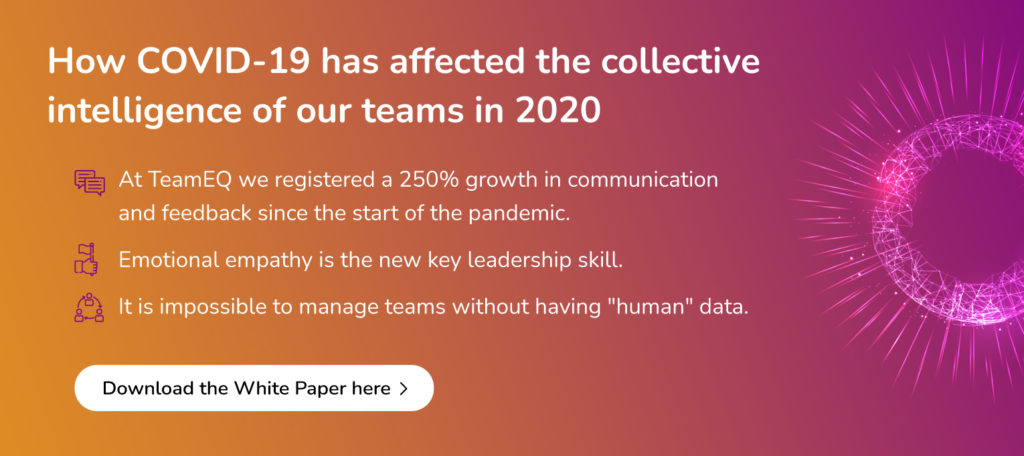How to avoid conflict in your remote teams
I’m often asked: what’s the biggest challenge to productivity and innovation in companies? My answer is always the same: finding ways to discover, anticipate and manage internal conflict.
The professional environment is an emotional breeding ground where we interact daily with groups of very diverse people. It is also the space where we nurture different emotional needs, such as belonging, recognition, identity… and, of course, it’s necessary for us to earn the money we need to meet our physical needs.
When we also add the pressure, tight resources, lack of communication and the uncertainty and lack of physical contact to which our teams are subjected today, we have all the ingredients for conflict to arise, even in the most experienced teams. And that can have a significant impact on their productivity and creativity.
Those of us trained in conflict resolution know that the key element to stop and even avoid the negative consequences of conflicts is their early identification. We are trained in the observation of intrapersonal dynamics and non-verbal communication. These can be very useful tools to help us identify the early signs of possible conflict… as long as we share a common physical space.
But now the professional reality has changed drastically, and in a rapid and unexpected way. Remote work and virtual teams have prevailed: we have swapped our offices for our homes, coffee jokes for memes in chats, meeting rooms for videoconferences … But what has not changed is our human nature or our emotional and physical needs. On the contrary, this situation has only increased those needs.
Today, having the ability to detect and manage conflicts in our virtual teams will be what distinguishes productive and innovative teams from those that fail to meet the challenge.
But how to manage, and even detect, internal conflicts in the era of remote working?
The answer is simple: trust the data!
Like communication channels or video calling apps, HR Analytics tools like TeamEQ have become essential on the desktops of digital teams.
As a Coach specialized in Cultural Transformation and Productivity, I rely on these tools to support myself in the observation and active listening of my teams. Thanks to the data they provide, I am able to detect and manage conflicts in teams before they have a direct impact on productivity.
Here some ways that an HR Analytics tool can simplify your team management and improve your skills in conflict management:
- Collecting data: the information and data that we previously got by observing and listening to our employees can now be obtained through specific questions aimed at measuring variables such as personal motivation, commitment, areas for improvement, and even asking directly about the level of conflict.
- Encouraging participation and a sincere response: One of the great advantages of these tools is that we do not need to trust our perception, but rather it is people who directly tell us how they feel and what they need.
- Reading the answers carefully: Active listening remains a key element in the digital management of teams. Analyzing and understanding these responses provides us with information to detect the possible situations of conflict where we need to intervene as leaders.
- Positive feedback: As in face-to-face communication, acknowledging feedback and responding to the doubts and concerns of our employees is essential to promote environments of trust.
- Analyzing the data and paying attention to the indicators: Some HR Analytics tools provide us with data on such important variables as trust, common goals, harmony, effectiveness, etc. These indicators clearly show us possible conflict situations, either through a drastic decrease in these variables or a large deviation in their score.
- Taking action: Once we perceive that there is a conflict, we must take the appropriate actions. This shows the team that their well-being matters to you and that their opinion is important.
- Monitoring the impact of your actions: These tools not only give us an image of the current situation, but also allow us to see the progression of the variables over time and the impact of the actions implemented.
In the midst of a global pandemic where we live with uncertainty and rigorous measures, companies need more than ever to minimize the individual and collective conflicts of their teams to ensure their productivity, innovation and continuity; and employees need channels to express their opinion, ideas and needs, helping them to know they are listened to and feeling that they continue to belong to a team and a company.
HR Analytics tools such as TeamEQ allow companies, leaders and employees to stay connected, offering the data that improves communication and team management in today’s ever more challenging environment.
By Eva Navarro, Coach & Team Analytics (TeamEQ)
Discover how TeamEQ can help you to manage conflict and boost productivity in your teams by taking a demo today.
Ph: Colaboración Ágil.




